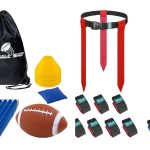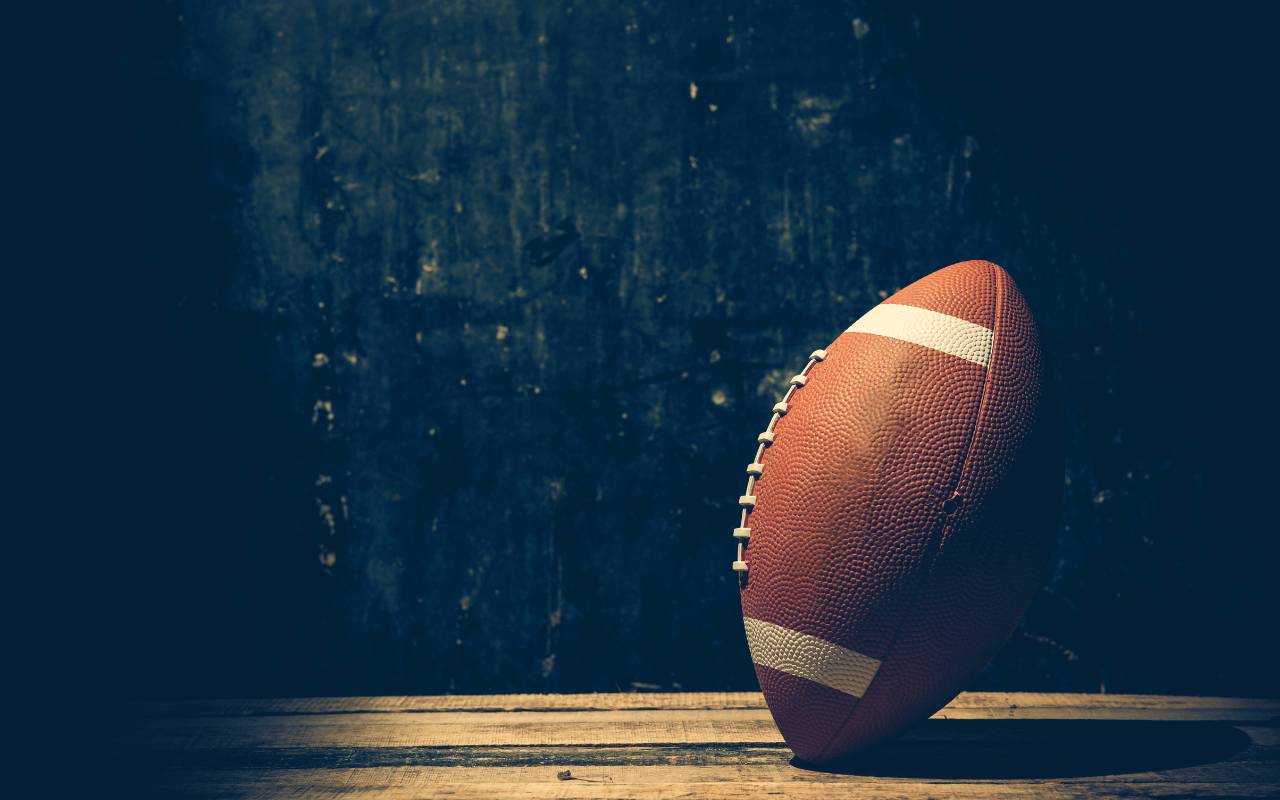Do you want to be an unbeatable flag football team? Of course, you do!
The following will discuss nine must-know offensive plays that will trick the opponent and help you achieve victory on the field. These plays are simple enough for beginners to learn but also complex enough to confuse the competition.
So whether you’re just starting out in flag football or looking to improve your game, read on for the best flag football plays around!
Here Are 9 Must-Know Flag Football Plays
1. The Hook and Ladder Play
The hook and ladder play is a classic flag football play that can be very effective if executed correctly. The basic idea is to have two players on the same team line up on either side of the field, with one player acting as the “hook” and the other as the “ladder.”
The hook player will run toward the opposing team’s defense and stops quickly to receive a pass while the ladder player runs parallel to them. After the hooked player catches the ball from the QB, they lateral it back to the ladder player, who will then attempt to catch it and run it into the end zone for a touchdown. To make this play work, it is important that both players have good timing and communication.
The hook player must be fast enough to get open, and the ladder player must be able to catch the ball and make a quick move upfield. The hook and ladder play can be a great way to trick the opposition and score a touchdown if executed correctly.
2. The Screen Pass Play
The Screen Pass is a play used in flag football. The play is designed to fool the defense into thinking the offensive team is running a sweep to one side when the ball carrier is going the other way behind a wall of blockers. To execute the play, the quarterback first fakes a handoff to one of the running backs going one way.
The quarterback then drops back as if he is going to pass the ball downfield. Meanwhile, the other running back and all of the receivers run toward the opposite side of the field, away from where the quarterback is standing. Then, as the defense begins to close in on him, the quarterback throws a quick pass to the running back, who is coming toward him from behind the line of scrimmage.
This running back then has a clear path to run for a touchdown. Screen passes can be very effective plays, but they are also risky because if the defense reads them correctly, they can be intercepted or stopped for a loss.
3. The Reverse Play
The Reverse Play is a great way to add some deception to your flag football game. It starts with the quarterback taking the center snap and handing it to a running back who then hands it off to a receiver going the opposite direction.
This play can be very effective because it often catches the defense off-guard and leads to big gains. If executed correctly, it can be a real game-changer. So if you’re looking to add some trickery to your football playbook, give the Reverse Play a try.
4. The Option Play
Option play is a running play used in football. The play is typically run by the quarterback, who has the option to hand the ball off or throw it to another player or keep it themselves and run with it. Option plays can be very effective, as they often catch the defense off-guard. However, they can also be risky, as the quarterback is often exposed to potential tackles.
For this reason, option plays are typically only used in certain situations, such as when the offense is trying to gain extra yardage or score a touchdown. Nevertheless, an option play can be a powerful weapon in any team’s arsenal when run correctly.
5. The Play Action Pass
One of the most common flag football plays is a play-action pass. The quarterback draws the ball back as if they are about to hand it off to a running back. However, instead of handing off the ball, the quarterback throws it to a receiver who is running downfield.
The key to making this play successful is to sell the handoff to the defense and then make an accurate throw to the receiver. This can be a very effective play if executed correctly, but it requires precision and timing from both the quarterback and the receiver. If you are looking to add a little unpredictability to your football game, give this fake play a try.
6. The Sneak Play
One popular flag football play is known as the “sneak play.” As its name suggests, the sneak play is designed to surprise the defense. The basic idea is for the offense to line up in one formation and then quickly shift into another form before the snap. This can confuse the defense and create an opportunity for a big gain.
To run a successful sneak play, it is important for the offense to be quick and decisive. The quarterback must make a quick decision on which receiver to target, and the receivers must be prepared to adjust their flight routes. If executed properly, a sneak play can be an effective way to catch the defense off-guard and pick up some easy yardage.
7. The Halfback Pass Play
The halfback pass play is one of the most common plays in flag football. The basic idea is for the quarterback to hand the ball off to the running back, who then runs around behind the line of scrimmage and looks for an open receiver. If the defense is playing a zone, he can usually find a receiver who has slipped past the linebackers and is open in the middle of the field.
If the defense is playing man-to-man, he can look for a receiver whose defender has come up to the line to stop the runner. Either way, the halfback pass play is a great way to pick up positive yardage.
8. The Statue of Liberty Play
The Statue of Liberty play is one of the most exciting flag football plays used today. The play is named after the famous statue in New York City and is designed to fool the defense into thinking the offense is running a different play. The key to the success of the play is to have the quarterback fake a pass to one side of the field and then hand to a running back going the other way
The play often results in a touchdown but can also lead to a big gain if the defense buys the fake pass. While the Statue of Liberty play can be difficult to execute, it can be a game-changer when used at the right time.
9. The Flea Flicker Play
The flea flicker play is one of the best flag football trick plays. The play is designed to catch the defense off-guard and can often result in a big gain or even a touchdown.
The basic idea behind the play is for the quarterback to hand the ball off to the running back, who then runs toward the line of scrimmage before pitching the ball back to the quarterback.
The quarterback can either throw a long pass downfield or keep the ball and run with it. While the flea-flicker play can be difficult to execute, it can be a very effective way to surprise the defense and pick up some easy yardage.
What Are Flag Football Offensive Plays?
There is a variety of flag football offensive plays that can be run to score touchdowns. One popular play is the double reverse, which involves two quick handoffs in order to confuse the defense. Another common play is the flea flicker, which uses a fake handoff to draw the defense in before passing the ball downfield.
Additionally, many teams will use trick plays such as lateral passes or halfback options to keep the defense guessing. Ultimately, the key to success on offense is to execute the plays with precision and to have a good understanding of the defense’s strengths and weaknesses. With a little creativity, any football team can put together a powerful offensive attack.
What Is A Flag Football Playbook?
The flag football playbook is an important part of any team’s success. After all, the plays determine how the game will be played. A well-designed playbook can give a team the winning edge, while a poorly designed one can leave them struggling to keep up. There are a few things to keep in mind when creating a playbook:
- It is important to have a variety of plays that can be run from different formations. This will keep the defense guessing and allow the offense to take advantage of mismatches.
- The plays should be designed to attack the weaknesses of the opposition while minimizing their strengths.
- The playbook should be flexible enough to be adjusted based on the specific situation of each game.
With these things in mind, any team can create a football playbook that gives them a chance to win.
What Are Flag Football Running Plays?
There are many different types of flag football running plays, each designed to exploit a specific weakness in the opposing team’s defense.
One of the most common running plays is the sweep, which involves a wide receiver or running back taking a handoff and running around the end of the line. This play is often used to catch the defense off-guard, as they will be expecting a play up the middle.
Another popular running play is the reverse, which involves a player from one side of the field running toward the other side behind the line of scrimmage. This can be effective for breaking through a defense that is focused on stopping plays up the middle.
There are many other types of running plays in football, each with its own advantages and disadvantages. The best way to determine which play will be most effective in a given situation is to experiment and find what works best against a specific opponent.
FAQ: Flag Football Plays
1. What are some good flag football plays?
Some good football plays include the sweep, the slant, and the screen.
The sweep is a running play that takes advantage of open-field space.
The slant is a passing play that uses quick, short passes to move the ball down the field.
The screen is a passing play that uses blockers to create space for the receiver.
These are just a few of the many types of plays that can be used in football. Ultimately, it is up to the coach to decide which plays will work best for their team.
2. What does each play start with in flag football?
Each play starts with the snap. The center will hike the ball between their legs to the quarterback, who will then have a few seconds to make a decision. Next, the quarterback can either hand the ball off to a running back, throw it to a receiver, or run it themselves.
Once the ball is in play, the offensive players must attempt to advance it down the field and into the end zone for a touchdown. Meanwhile, the defensive players will try to stop them by tackling them or pulling their flags.
3. What are plays called in flag football?
Plays are typically named after their main purpose or the player who is responsible for carrying out the play. For example, a play designed to get the ball to a wide receiver would be called a “pass play.”
Similarly, a play that features a running back carrying the ball up the middle of the field would be called a “run play.” There are also plays that are named after their formation, such as the “I-formation” or the “spread formation.” Ultimately, each team has its own playbook full of different plays that they can call at any time.
4. What plays are not allowed in flag football?
There are several plays that are not allowed in flag football. These include the “blindside block,” the “clip,” and the “leap.”
Additionally, players are not allowed to hold or grab opposing players or contact them in a dangerous manner.
Finally, all players must wear flags that are easily visible and accessible at all times. If a player does not have a flag, they cannot participate in the play and will be subject to penalties.
4. How do you make flag football plays?
Flag football plays 7v7 and 5v5 can be created in a number of ways.
Many websites offer free football playbooks that can be downloaded and printed. Finally, some teams create their own plays by drawing them up on a whiteboard or piece of paper.
You can also check out this book:
5. How to design flag football plays?
When designing plays, coaches should first consider the desired outcome of the play. For example, if the goal is to score a touchdown, then the play should be designed to get the ball into the end zone. If the goal is to gain first down yardage, then the play should be designed to move the ball down the field.
Once the coach knows what they want to accomplish, they can begin designing the play. The coach will need to determine the formation, assign players to positions, and decide how each player will execute their role in the play. Finally, the coach should practice the play with their team so that everyone understands their assignment.
Take a look at look at these youth flag football coaching tips.
6. What are some common flag football penalties?
Some common penalties include offsides, false starts, delay of game, and illegal procedure. Offsides occur when a defensive player crosses the line of scrimmage before the snap. A false start happens when an offensive player moves prior to the snap.
A delay of the game is called when the offense fails to snap the ball within the allotted time. Finally, an illegal procedure is called when an offensive player breaks one of the rules regarding the formation of eligible receivers.
7. What is a good flag football team name?
When choosing a team name, coaches should consider the personality of their team. For example, an aggressive team that likes to score touchdowns might choose a name like the “Titans” or the “Raiders.”
On the other hand, a team that is more laid back and focuses on having fun might choose a name like the “Beach Bums” or the “Island Boys.” Ultimately, the best team name is one that reflects the unique personality of the team.
Need some more inspiration? Check out our list of 101 flag football team names.
Become A Flag Football Pro In No Time
Flag football is a great way to stay active and have fun. With these simple tips, you will be well on your way to becoming a pro in no time.
Just remember to always practice the plays with your team before using them in a game. This will ensure that everyone is on the same page and knows their assignment. With a little bit of preparation, your team will be able to dominate the competition and come out victorious.

Vance J has played flag football since he was a boy. Since then, he has become a coach and a huge advocate for growing the sport. He loves to write and talk about flag football!













